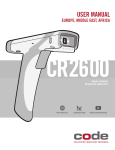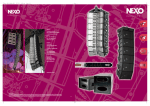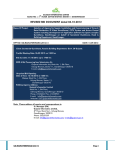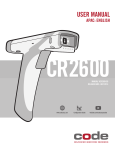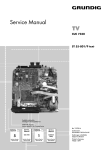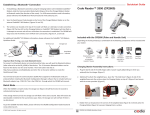Download DCE™ Rack System - Emerson Network Power
Transcript
DCE™ Rack System User Manual Table of Content Important Safety Instructions. . . . . . . . . . . . . . . . . . . . . . . . . . . . . . . . . . . . . . 1 1.0 What’s Included . . . . . . . . . . . . . . . . . . . . . . . . . . . . . . . . . . . . . . . . . . . . . . 2 2.0 Installation . . . . . . . . . . . . . . . . . . . . . . . . . . . . . . . . . . . . . . . . . . . . . . . . . . 3 2.1 Receiving, Unpacking, and Removing the DCE Rack from the Pallet . . . . . . . . . . . . . . . . 3 2.2 Loading Equipment . . . . . . . . . . . . . . . . . . . . . . . . . . . . . . . . . . . . . . . . . . . . . . . . . . . . . . . 3 2.3 Operating Door Handle . . . . . . . . . . . . . . . . . . . . . . . . . . . . . . . . . . . . . . . . . . . . . . . . . . . . 4 2.4 Reversing the door handle . . . . . . . . . . . . . . . . . . . . . . . . . . . . . . . . . . . . . . . . . . . . . . . . . 5 2.5 Door Removal and Attachment . . . . . . . . . . . . . . . . . . . . . . . . . . . . . . . . . . . . . . . . . . . . . . 6 2.6 Field-reversible Front and Rear Doors . . . . . . . . . . . . . . . . . . . . . . . . . . . . . . . . . . . . . . . . 7 2.7 Side Panel Removal . . . . . . . . . . . . . . . . . . . . . . . . . . . . . . . . . . . . . . . . . . . . . . . . . . . . . . 8 2.8 Top Panel Mounting . . . . . . . . . . . . . . . . . . . . . . . . . . . . . . . . . . . . . . . . . . . . . . . . . . . . . . 8 2.9 Caster and Leveling Feet Mounting . . . . . . . . . . . . . . . . . . . . . . . . . . . . . . . . . . . . . . . . . . 9 2.9.1 Field installation of casters . . . . . . . . . . . . . . . . . . . . . . . . . . . . . . . . . . . . . . . . . . . . . . . . . 9 2.9.2 Leveling Feet Adjustment . . . . . . . . . . . . . . . . . . . . . . . . . . . . . . . . . . . . . . . . . . . . . . . . . 12 2.10 Mounting Rails. . . . . . . . . . . . . . . . . . . . . . . . . . . . . . . . . . . . . . . . . . . . . . . . . . . . . . . . . 12 2.11 Rail Adjustment . . . . . . . . . . . . . . . . . . . . . . . . . . . . . . . . . . . . . . . . . . . . . . . . . . . . . . . . 13 2.12 PDU/Cable-management Brackets . . . . . . . . . . . . . . . . . . . . . . . . . . . . . . . . . . . . . . . . . 14 3.0 Optional Accessories . . . . . . . . . . . . . . . . . . . . . . . . . . . . . . . . . . . . . . . . 15 3.1 Vertical Cable Manager Kit: E846015 . . . . . . . . . . . . . . . . . . . . . . . . . . . . . . . . . . . . . . . . 15 3.2 Horizontal Front-to-rear Cable Manager: E11015/E12015 . . . . . . . . . . . . . . . . . . . . . . . . 17 3.3 Front-to-rear Cable Trough: E811015/E812015 . . . . . . . . . . . . . . . . . . . . . . . . . . . . . . . . 17 3.4 Adjustable Ladder-rack Bracket: ELRB016. . . . . . . . . . . . . . . . . . . . . . . . . . . . . . . . . . . . 19 3.5 Overhead cable trough: E6016/7016/8016 . . . . . . . . . . . . . . . . . . . . . . . . . . . . . . . . . . . . 20 3.6 Exhaust Chimney: E1832014/E3246014 . . . . . . . . . . . . . . . . . . . . . . . . . . . . . . . . . . . . . 20 3.7 Vertical-airflow Baffle with Brush Kit for 800mmW Rack: E48801/E428014/E458014 . . . 21 3.8 Vertical-airflow Baffle with Brush Kit for 700mmW Rack: E487014/E427014/E457014 . . 22 3.9 Vertical-airflow Baffle with Brush Kit and Vertical Cable Manager . . . . . . . . . . . . . . . . . . 23 3.10 Baying Gasket Kit: E4013 (for 24”W spacing only) . . . . . . . . . . . . . . . . . . . . . . . . . . . . . 24 3.11 Baying Kit: E9013 . . . . . . . . . . . . . . . . . . . . . . . . . . . . . . . . . . . . . . . . . . . . . . . . . . . . . . 24 i DCE™ Rack System User Manual Important Safety Instructions Important Safety Instructions SAVE THESE INSTRUCTIONS This manual is provided to prevent service personnel from committing an act that results in the risk of fire, electric shock, or injury to persons. Only trained service personnel should receive, unpack, and assemble the DCE Racks. In addition, only trained service personnel should install equipment in racks. SAFETY SYMBOLS USED IN THIS MANUAL This manual provides general safety guidelines to be observed during installation, operation, and maintenance of the DCE Rack. ! WARNING Failure to follow directions in the warning could result in injury to persons or loss of life. ! CAUTION Failure to follow directions in the caution could result in damage to equipment or storage data. SAFETY CONSIDERATIONS ! WARNING Improper handling and use of the DCE Rack could result in equipment damage, serious injury, or possible death. Only trained service personnel should be used to remove the rack from the pallet. Also, be sure you have a sufficient number of service personnel. Do not attempt to move racks by yourself. All wiring and electrical circuits must be in compliance with National and Local electric codes. Only ITE (Information Technology Equipment) bearing the safety compliance mark of a NRTL should be installed inside the DCE Rack. NRTL compliance marks include UL®, C-UL®, CSA®, ETL®, TUV®, and CE. Be sure to read and follow all individual manufacturer equipment manuals for safety and installation instructions. Proper spacing is required when installing electrical equipment to avoid electrical shock. Maintain minimum spacing between the accessories and components and the computer rack assembly for safe operation of the equipment when installed in accordance with the National Electric Code ANSI/NFPA 70-1999. SUPPORT For technical support for your DCE Rack contact Emerson Technical Support at 1-800-222-5877 or at [email protected]. To locate your nearest distributor or sales office, visit the About US link at http://www.emersonnetworkpower.com/. DCE™ Rack System User Manual 1 What’s Included 1.0 What’s Included • DCE unit (assembled) • Keys as needed (depending on configuration) • (50) M6 cage nuts (3/8” square) and M6 screws • Baying hardware • Edge grommet • This User Manual This user’s manual applies to the following pre-configured and applicable configured Emerson racks: Part No. RU W (mm) D (mm) E24611 24 600 1100 E42611 42 600 1100 E42612 42 600 1200 E42711 42 700 1100 E42712 42 700 1200 E42811 42 800 1100 E42812 42 800 1200 E45611 45 600 1100 E45612 45 600 1200 E45711 45 700 1100 E45712 45 700 1200 E45811 45 800 1100 E45812 45 800 1200 E48611 48 600 1100 E48612 48 600 1200 E48711 48 700 1100 E48712 48 700 1200 E48811 48 800 1100 E48812 48 800 1200 DCE static weight capacity: 3000 lbs. DCE dynamic weight capacity: 2500 lbs. 2 DCE™ Rack System User Manual Installation 2.0 Installation 2.1 Receiving, Unpacking, and Removing the DCE Rack from the Pallet Inspect and report any damage before receiving. Unpack the rack by carefully removing the corrugated carton and corners. Avoid damaging the rack when removing packaging. ! WARNING Only trained service personnel should be used to remove the rack from the pallet. Also, be sure you have a sufficient number of service personnel. Do not attempt to move racks by yourself. ! WARNING Be careful when moving racks before installation. Sudden stops and starts, excessive force, obstructed routes, and uneven floor surfaces may cause the rack to topple over. 2.2 Loading Equipment ! WARNING Only install equipment after the DCE Rack has been properly secured. Do not move the DCE Rack assembly while loaded. Once in place at the desired/intended location, deploy the leveling feet for maximum stability. Rated or maximum-load capacity for the DCE Rack is 3000 pounds on the floor or on leveling glides. To maintain a uniform distribution of the mechanical load in the DCE Rack, load the heaviest equipment first, at the bottom of the DCE Rack and load the lighter units at the top. DCE™ Rack System User Manual 3 Installation 2.3 Operating Door Handle The door swing handles have been installed at the manufacturer. No additional assembly is required. To operate the swing handle, lift up at the bottom of the handle then swing the handle to the right to open. The handle must be kept in this position to close the door. Return the handle to the initial position and use the key provided to lock the handle. The lock on the side panels will accept the same key. The swing handles and doors are reversible. Lift up handle Swing handle 4 DCE™ Rack System User Manual Installation 2.4 Reversing the door handle Remove the phillips head bolt from the swing handle retainer on the inside of the door. Tilt the handle outwards and lift up to remove it from the door. Remove the phillips head cam retaining bolt. Rotate the cam 180° and re-install cam retaining bolt. After reversing the door, reinstall the swing handle by sliding downwards into door and tilting inwards. Re-install swing handle retainer and phillips head bolt. Phillips Head Bolt Phillips Head Cam Retaining Bolt Retainer Cam DCE™ Rack System User Manual 5 Installation 2.5 Door Removal and Attachment Before removing doors, grounding wires must be disconnected. Open the door beyond 90° then pull on the hinge pins. Carefully pull the door away from the rack to detach the door. To attach the door, align the hinges and slide hinge pins back into the hinge assembly. A B 6 DCE™ Rack System User Manual Installation 2.6 Field-reversible Front and Rear Doors The front and rear doors are installed right-hand hinged from the factory. To change to left-hand hinge, follow door-removal instructions then remove the torx screws that attach the hinges to the frame. To re-install the hinges on the left side of the frame: • Use the former top-right hinge at the bottom left and the former bottom-right hinge at the top left with the open end of the hinge facing the outside of the rack. • Remove and re-install the catch plate on the opposing side with the bend toward the inside of the rack. • Then rotate the door 180° and slide the hinge pins into the assembly. • When the door is reversed the handle must also be rotated 180°; see “Reversing the door handle” on page 5. M6 Torx Screw; T30 screwdriver required C DCE™ Rack System User Manual 7 Installation 2.7 Side Panel Removal Before removing side panels, grounding wires must be disconnected. The side panels are secured to the rack frame with a keyed lock. To remove the side panel, unlock the panel, tilt the top of the side panel out slightly and lift the side panel up a couple of inches until it is free. To install the side panel, reverse the process and lock the panel. Make sure the slots on the side panel engage with the two tabs at the bottom of the frame. 2.8 Top Panel Mounting The top panel of the rack is installed at the manufacturer. Removing the top panel can be done by removing the six, M4 torx screws with a T15 screwdriver. Then simply lift the top panel out or off. There are 3 top panel options for DCE Racks: M4 Torx Screw; T15 screwdriver required Use the supplied edge grommet to line the perimeter of any top panel cutout; cut grommet to length and line each cutout 8 DCE™ Rack System User Manual Installation 2.9 Caster and Leveling Feet Mounting ! CAUTION • To install casters, the rack must be tipped onto its side. The rack can be very heavy, several people will be required in this process. Please practice safe lifting techniques. • DO NOT lay the rack on its front or back, this may damage the door hinges. • Removing doors and sides will help reduce the weight of the rack. • Before tipping, remove the side panels to prevent damage to the locks and latches. 2.9.1 Field installation of casters 1. To install casters, the rack must first be tipped over onto/laid on its side. NOTE Be sure to install swivel casters on the front of the rack and fixed casters on the rear. A, B &C DCE™ Rack System User Manual D 9 Installation 2. Swivel casters install on the front of the rack. The longer side of the caster assembly features 2 holes; align the holes over the M8 pem studs that are located on the side of the frame; secure with M8 keps nut and tighten to 18 ft-lb.; see Figure 2-1. Figure 2-1 Caster installation - Detail A Swivel Caster Assembly M8 Keps Nut; 13mm socket required Front of Rack Leveling Foot Side of Frame M8 Pem Studs 3. The flange of the caster assembly will align with a hole on the side of the frame; secure with a M6 carriage bolt and nut and tighten to 7.5 ft-lb. The shorter side of the caster assembly will align with a hole on the front/rear of the frame; secure with a M8 Bolt and tighten to 18 ft-lb.; see Figure 2-2. Figure 2-2 Caster installation - Detail B M8 Bolt M6 Carriage Bolt 10 M6 Nut DCE™ Rack System User Manual Installation 4. Once front-swivel caster assemblies are installed, a support bar will connect the two casters. Align the holes on the end of the support beam with the M8 pem studs on the caster assembly; secure with M8 keps nut and tighten to 18 ft-lb.; see Figure 2-3. Figure 2-3 Caster installation - Detail C M8 Pem Studs M8 Keps Nuts; 13mm socket required 5. Fixed casters install on the rear of the rack and are installed in the same manner as the front swivel casters. Repeat steps 2-4; see Figure 2-4. Figure 2-4 Caster installation - Detail D Fixed Caster Assembly installed DCE™ Rack System User Manual Rear of Rack 11 Installation 2.9.2 Leveling Feet Adjustment Leveling feet are preinstalled at the factory. They are easily accessible in the front and rear of the rack frame. To adjust the leveling feet from inside the rack, a 5/16 socket is required. Leveling feet can also be adjusted from beneath the rack with a 3/4 open-end wrench; see Figure 2-5. Figure 2-5 Leveling-feet adjustment detail To adjust leveling feet from inside rack, 5/16 socket is required To adjust leveling feet from outside rack, 3/4 open end wrench is required Counter-clockwise rotation adjusts the leveling feet up Clockwise rotation adjusts the leveling feet down 2.10 Mounting Rails The vertical mounting rails (each rack has two pairs, 12 ga. steel, powder-coated rails) come installed with all standard frames at 19" EIA 310-E. Universal cage nut rails (M6) are standard. Rack Mount Units (RU) are marked on the front and rear of the rails for easy equipment mounting. Accessory Mounting Holes (AMH), rectangular cable pass-through holes, and vertical cable tie-down slots can be found on side of rails. Hole pattern to accept lobster claws Vertical mounting rail Rectangular cable pass through cut outs Accessory mounting holes (AMH) Vertical cable tie-down slots 12 DCE™ Rack System User Manual Installation 2.11 Rail Adjustment ! CAUTION Do NOT attempt to adjust rails once equipment has been loaded. Rails are attached using an M6 carriage bolt and M6 keps nut. By loosening the top, bottom and middle bolts using a 10mm drive socket, the rails can be adjusted infinitely from front to back. The DCE rails have also been designed with a “Locking Rail” feature. This feature is designed to insure the rails maintain their position once the desired rail position has been set. If the application requires it, engage the locking feature by turning the locking tab around and inserting into the rail and into the slot on the horizontal support. M6 Carriage Bolt 65 55 50 Horizontal Depth Markings 45 40 35 40 Front to Rear Rack Horizontal Locking Tab DCE™ Rack System User Manual 13 M6 Keps Nut Installation 2.12 PDU/Cable-management Brackets PDU/Cable Management Brackets can be installed in each rear corner of the rack. They are secured to the rack at the top, center, and bottom rack horizontal. Keyhole cutouts along the bar accept button-mounting of PDUs. The rectangular hole pattern accepts “D” rings, lobster claws, and a variety of other cable management. 2.200 4.409 .500 A .072 THK Detail B “E” to CL .500 B 61.250(2) 37.750(2) 12.250(2) M6 Keps Nut Keyhole cutouts to accept button mounting of PDUs Hole pattern to accept “D” rings, lobster claws, and other cable management M6 Screw Detail A ! WARNING When using power distribution units (PDUs), each PDU should be connected to a dedicated branch circuit that is rated for the continuous load of all the equipment connected. When not using a PDU, each piece of equipment should be connected to a dedicated branch circuit. 14 DCE™ Rack System User Manual Optional Accessories 3.0 Optional Accessories 3.1 Vertical Cable Manager Kit: E846015 Installation of Vertical Cable Manager kit requires the EIA rails to be recessed a total of 4.75" from the front of the rack. When installing the vertical cable manager kit in 600mmW racks, AMH adapter brackets are required. To install the adapter brackets, the bent tabs must be aligned and inserted in the cut-out pattern on the outside surface of the EIA rail. Then proceed to install each adapter bracket with 14 panel fasteners. Each of the vertical cable managers are then installed using (4) flathead M6 screws on the face of the adapter brackets, facing outward. The vertical cable manger kit installed in 700 and 800mmW racks does not require AMH adapter brackets. Vertical cable manager will mount directly to the AMH of the EIA rail. Vertical Cable Manager Kit can be installed with a Vertical Airflow Baffle with Brush Kit. See page 23. AMH Adapter Bracket for 600mmW rack only Tabs along bracket to install in cutout pattern along EIA rail Top view of AMH Adapter Bracket A Vertical Cable Manager installation Screw (4 per manager) Detail A AMH Bracket AMH Bracket installation; (14) push fasteners per bracket AMH Bracket for 600mmW racks only; vertical cable manager will mount directly to the EIA rail in 700 aand 800mmW racks DCE™ Rack System User Manual 15 7 RU Vertical Cable Manager Optional Accessories Top Cross Section View of Installation EIA Rail AMH Bracket installation fastener (plastic push rivet) Vertical Cable Manager installation screw (M6 x 12 Torx Screw) Adapter Bracket Vertical Cable Manager 16 DCE™ Rack System User Manual Optional Accessories 3.2 Horizontal Front-to-rear Cable Manager: E11015/E12015 The front-to-rear horizontal cable manager for 800W units allows cabling to be managed from front to back of the DCE rack. The horizontal manager will accept lobster claw managers (part # 002185050), Velcro Strap Managers (part # 002185060), and has slots to accept cable ties. The manager fastens to the frame in four different places, the top two middle locations and the bottom. The managers come in two depths 1100mm and one for 1200mm racks. A M6 Hex HD Bolt Lacing bar can be installed in any of the rectangular cutouts found along the mounting rail Mounting Rail 3.3 Front-to-rear Cable Trough: E811015/E812015 The 800mm wide racks with depths of 1100mm and 1200mm have the option for front-to-rear cable troughs. These troughs will adjust with the movement of the mounting rails. • E811015: Adjustable from 20.188" to 33.464" • E812015: Adjustable from 22.188" to 38.464" 1. Measure front to back distance between EIA rails from inside to inside mounting planes 2. Loosen or remove (2) center screws to allow for adjustment and movement of inner and outer members 3. Proceed to install trough into rack by finding the cut outs with (2) holes right below cut out. 4. From inside of rack between rails, lift unit and engage tab through cut out and drop in place 5. Slide the other trough member to engage tab as done in step 4 DCE™ Rack System User Manual 17 Hex Nut Optional Accessories 6. Proceed to install all screws, (2) front and (2) back through tab holes into EIA rail holes 7. Lastly install the (2) center screws to secure inner and out trough members See Note 7 See Note 4 See Note 6 See Note 6 Trough Assembly See Notes 2&7 Outer Trough Assembly Inner Trough Assembly See Note 6 18 DCE™ Rack System User Manual Optional Accessories 3.4 Adjustable Ladder-rack Bracket: ELRB016 The adjustable ladder rack and basket tray support bracket allows most third-party ladder racks or trays to be installed on the top of DCE racks. The bracket accepts racks or trays from 12",18” and 24" widths. Heights can be adjusted to accommodate the difference in height between racks. There are many mounting holes in the top panel to accommodate the placement of the brackets. Two brackets are recommended per rack. Ladder rack shown for reference only 5/16-18 x 3” J-Bolt Adjust top section of ladder rack support kit to desired height prior to final tightening of carriage bolts and hex nuts 1/4-20 Hex Nut w/ Serrated Flanged Head 1/4-20 Carriage Bolt 5/16” Flat Washer 5/16”-18 Hex Nut Square hole pattern to insert M6 cage nuts M6 Hex HD Bolt w/ Serrated Flanged Head M6 Cage Nut DCE™ Rack System User Manual 19 Optional Accessories 3.5 Overhead cable trough: E6016/7016/8016 When ordered with the rack, the troughs ship assembled, but not installed. When ordered separately, the trough will still ship assembled. The top of the DCE rack has a variety of mounting holes. Place the trough where you require cable routing. Insert a cage nut into the appropriate square hole on the top panel, and secure the trough on top with M6 screws. For 600mm wide racks use DCE6016, for 700mm wide racks use DCE7016 and for 800mm wide racks use DCE8016. Install where desired; insert M6 cage nuts into square hole on top panel and secure trough with (4) M6 screws 3.6 Exhaust Chimney: E1832014/E3246014 The chimney top panel allows an exhaust chimney to be installed. Place the chimney on top of the opening in the top panel and secure it from inside the rack with four #10-32 x 1/2”L screws. Raise the outer section of the chimney so the rubber seal touches the ceiling. When the chimney is at the desired height, use a screwdriver to punch out the appropriate knockout along each side of the chimney; insert the chimney knob into the knockout to secure the chimney. • E1832014: Adjustable 18" to 32"H; 18.75"W x 14.3"D • E3246014: Adjustable 32" to 46"H; 18.75"W x 14.3"D Use a screwdriver to punch out appropriate knockouts; secure with chimney knob Fully-extended Chimney Fully-compessed Chimney 20 DCE™ Rack System User Manual Optional Accessories 3.7 Vertical-airflow Baffle with Brush Kit for 800mmW Rack: E48801/E428014/E458014 The vertical airflow baffle with brush kit can be installed in 42, 45, and 48 RU racks that are 800mmW. The kit installs using the accessory mounting holes (AMH) along the rail. It is used to prevent air recirculation within the rack. Push tool-less rivets thru 1/4” holes on front face of EIA rails Top cross plate provided to be installed in the first AMH on all racks Flexible PVC brush strips slide onto outside edges of mounting plates that are installed onto front face of each of (2) equipment mounting rails. Ensure that the grommet is fully engaged with mounting plates for proper seal. Vertical brush strip mounting plate with (2) RU break off intervals provided for 45 RU and 42 RU configurations. Top View of Brush Grommet Installed EIA Rail Vertical Brush Mounting Plate DCE™ Rack System User Manual 3” Brush Grommet 21 Optional Accessories 3.8 Vertical-airflow Baffle with Brush Kit for 700mmW Rack: E487014/E427014/E457014 The vertical airflow baffle with brush kit can be installed in 42, 45, and 48 RU racks that are 700mmW. The kit installs using the accessory mounting holes (AMH) along the rail. It is used to prevent air recirculation within the rack. Top cross plate provided to be installed in the first AMH on all racks Push tool-less rivets thru 1/4” holes on front face of EIA rails Flexible PVC brush strips slide onto outside edges of mounting plates that are installed onto front face of each of (2) equipment mounting rails. Ensure that the grommet is fully engaged with mounting plates for proper seal. Vertical brush strip mounting plate with (2) RU break off intervals provided for 45 RU and 42 RU configurations. Top View of Brush Grommet Installed EIA Rail Vertical Brush Mounting Plate 3” Brush Grommet 22 DCE™ Rack System User Manual Optional Accessories 3.9 Vertical-airflow Baffle with Brush Kit and Vertical Cable Manager The brush grommet rail kit and vertical cable manager can be installed together. Installation of vertical cable manager requires the EIA rails to be recessed a total of 4.75" from the front of the rack. When installing both, place a vertical cable manager on top of the mounting plate of the vertical airflow baffle; align with the AMH. Insert a tool-less rivet through both the vertical cable manager and mounting plate. AMH along EIA rail Push tool-less rivets thru 1/4” holes on front face of EIA rails Vertical Brush Mounting Plate DCE™ Rack System User Manual 23 Optional Accessories 3.10 Baying Gasket Kit: E4013 (for 24”W spacing only) When baying racks together on 24" centers, a Baying Gasket Kit should be used to seal the gap left between the racks to maintain proper hot-aisle/cold-aisle best practices. Gasket must be installed before baying racks. Measure and cut gasket to length; peel adhesive backing and place gasket around side perimeter of one of the racks. Once the gasket is installed and racks are positioned next to each other, racks can be bayed. 3.11 Baying Kit: E9013 Place racks in a row and open or remove doors for easy access to frame holes. Decide spacing between rack centers, 24" or 600mm (see Detail B for bracket screw hole selection). Install baying bracket as shown in Detail A (2 at front and 2 at rear per rack’s mating planes). Use this screw hole position for 24” centers A Use this screw hole position for 600mm centers Baying Bracket Detail A 24 M6 Fh Torx Screw Detail B DCE™ Rack System User Manual Technical Support / Service Web Site www.liebert.com Monitoring [email protected] 800-222-5877 Outside North America: +00800 1155 4499 Single-Phase UPS & Server Cabinets [email protected] 800-222-5877 Outside North America: +00800 1155 4499 Three-Phase UPS & Power Systems 800-543-2378 Outside North America: 614-841-6598 Environmental Systems 800-543-2778 Outside the United States: 614-888-0246 Locations United States 1050 Dearborn Drive P.O. Box 29186 Columbus, OH 43229 Europe Via Leonardo Da Vinci 8 Zona Industriale Tognana 35028 Piove Di Sacco (PD) Italy +39 049 9719 111 Fax: +39 049 5841 257 Asia 7/F, Dah Sing Financial Centre 108 Gloucester Road, Wanchai Hong Kong 852 2572220 Fax: 852 28029250 While every precaution has been taken to ensure the accuracy and completeness of this literature, Liebert Corporation assumes no responsibility and disclaims all liability for damages resulting from use of this information or for any errors or omissions. © 2015 Liebert Corporation All rights reserved throughout the world. Specifications subject to changewithout notice. ® Liebert is a registered trademark of Liebert Corporation. All names referred to are trademarks or registered trademarks of their respective owners. SL-11992_REV1_12-15 Emerson Network Power Web: www.emerson.com





























